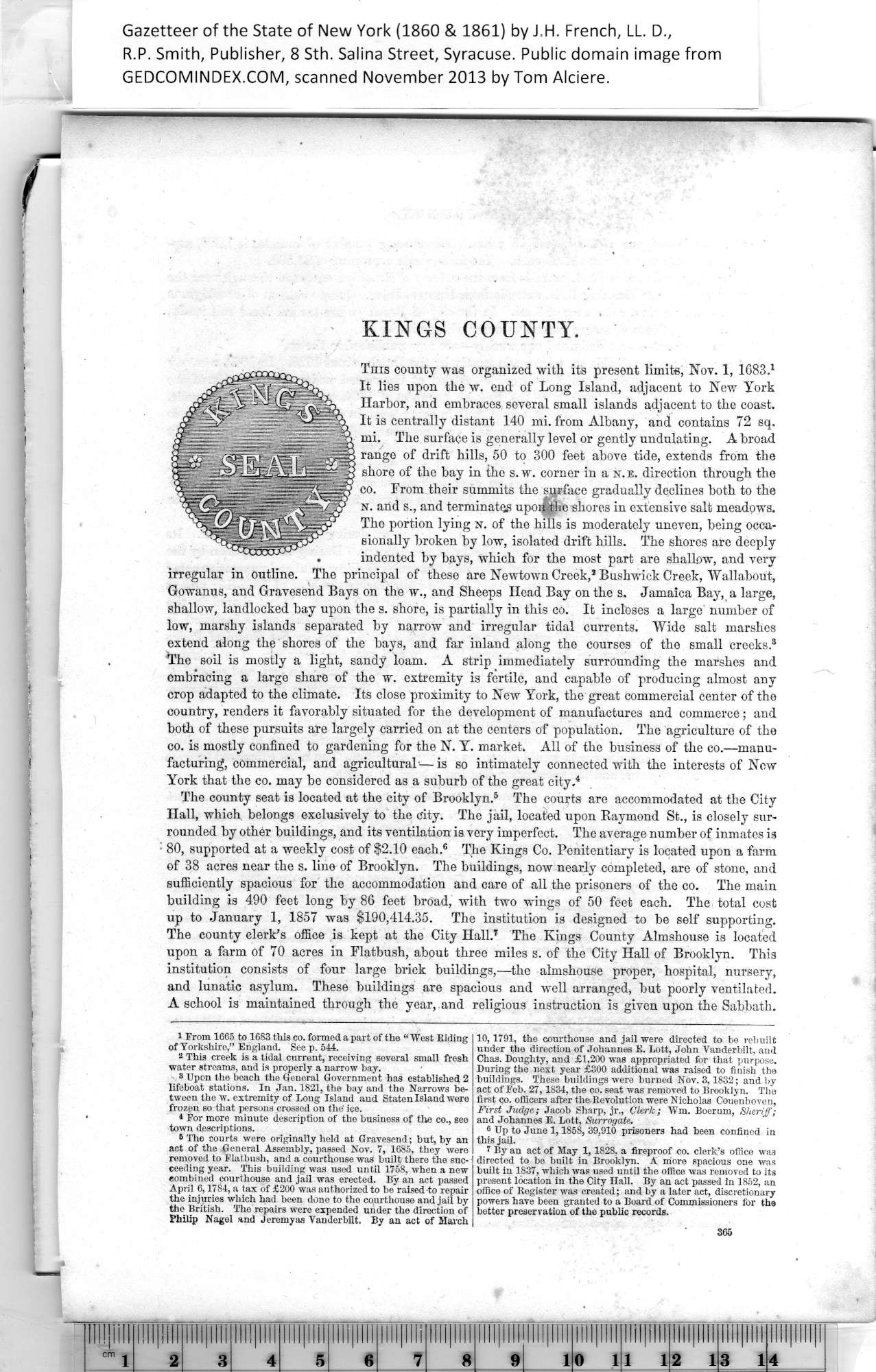|
KINGS COUNTY.
This county was organized with its present limits, Nov. 1, 1683.1
It lies upon the w. end of Long Island, adjacent to New York
Harbor, and embraces several small islands adjacent to the coast.
It is centrally distant 140 mi. from Albany, and contains 72 sq.
mi. The surface is generally level or gently undulating. A broad
range of drift hills, 50 to 300 feet above tide, extends from the
shore of the bay in the s.w. corner in a n.e. direction through the
co. From their summits the surface gradually declines both to the
n. and s., and terminates upoiithe shores in extensive salt meadows.
The portion lying n. of the hills is moderately uneven, being occa¬
sionally broken by low, isolated drift hills. The shores are deeply
indented by bays, which for the most part are shallow, and very
irregular in outline. The principal of these are Newtown Creek,* Bushwick Creek, Wallabout,
Gowanus, and Gravesend Bays on the w., and Sheeps Head Bay on the s. Jamaica Bay, a large,
shallow, landlocked bay upon the s. shore, is partially in this co. It incloses a large number of
low, marshy islands separated by narrow and irregular tidal currents. Wide salt marshes
extend along the shores of the bays, and far inland along the courses of the small creeks.2
The soil is mostly a light, sandy loam. A strip immediately surrounding the marshes and
embracing a large share of the w. extremity is fertile, and capable of producing almost any
crop adapted to the climate. Its close proximity to New York, the great commercial center of the
country, renders it favorably situated for the development of manufactures and commerce; and
both of these pursuits are largely carried on at the centers of population. The agriculture of the
co. is mostly confined to gardening for the N. Y. market. All of the business of the co.—manu¬
facturing, commercial, and agricultural — is so intimately connected with the interests of Now
York that the co. may be considered as a suburb of the great city.3
The county seat is located at the city of Brooklyn.4 The courts are accommodated at the City
Hall, which belongs exclusively to the city. The jail, located upon Raymond St., is closely sur¬
rounded by other buildings, and its ventilation is very imperfect. The average number of inmates is
: 80, supported at a weekly cost of $2.10 each.5 The Kings Co. Penitentiary is located upon a farm
of 38 acres near the s. line of Brooklyn. The buildings, now nearly completed, are of stone, and
sufficiently spacious for the accommodation and care of all the prisoners of the co. The main
building is 490 feet long by 86 feet broad, with two wings of 50 feet each. The total cost
up to January 1, 1857 was $190,414.35. The institution is designed to be self supporting.
The county clerk’s office is kept at the City Hall.T The Kings County Almshouse is located
upon a farm of 70 acres in Flatbush, about three miles s. of the City Hall of Brooklyn. This
institution consists of four large brick buildings,—the almshouse proper, hospital, nursery,
and lunatic asylum. These buildings are spacious and well arranged, but poorly ventilated.
A school is maintained through the year, and religious instruction is given upon the Sabbath.
|
10,1791, the courthouse and jail were directed to be rebuilt
under the direction of Johannes E. Lott, John Vanderbilt, and
Chas. Boughty, and £1,200 was appropriated for that purpose.
During the next year £300 additional was raised to finish the
buildings. These buildings were burned Nov. 3,1832; and by
act of Feb. 27,1834, the co. seat was removed to Brooklyn. The
first co. officers after the Revolution were Nicholas Couenhoven,
First Judge; Jacob Sharp, jr., Clerk; Wm. Boerum, Sheriff;
and Johannes E. Lott, Surrogate.
6 Up to June 1,1858, 39,910 prisoners had been confined in
this jail.
7 By an act of May 1, 1828, a fireproof co. clerk’s office was
directed to be built in Brooklyn. A more spacious one was
built in 1837, which was used until the office was removed to its
present location in the City Hall. By an act passed In 1852, an
office of Register was created; and by a later act, discretionary
powers have been granted to a Board of Commissioners for the
better preservation of the public records. |
1
From 1665 to 1683 this co. formed a part of the “ West Riding
of Yorkshire,” England. See p. 544.
2
8 Upon the beach the General Government has established 2
lifeboat stations. In Jan. 1821, the bay and the Narrows be¬
3
tween the w. extremity of Long Island and Staten Island were
frozen so that persons crossed on the ice.
4
* For more minute description of the business of the co., see
town descriptions.
5
Tho courts were originally held at Gravesend; but, by an
act of the General Assembly, passed Nov. 7, 1685, they were
removed to Flatbush, and a courthouse was built there the suc¬
ceeding year. This building was used until 1758, when a new
combined courthouse and jail was erected. By an act passed
April 6,1784, a tax of £200 was authorized to be raised to repair
the injuries which had been done to the courthouse and jail by
the British. The repairs were expended under the direction of
Philip Nagel and Jeremyas Vanderbilt. By an act of March
|
